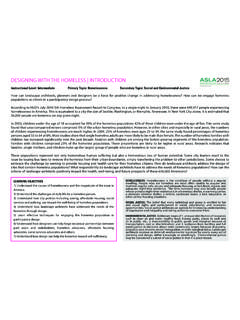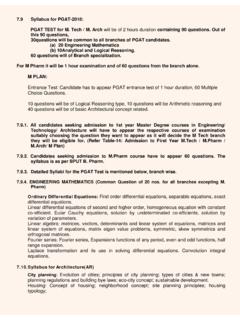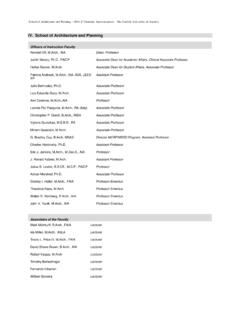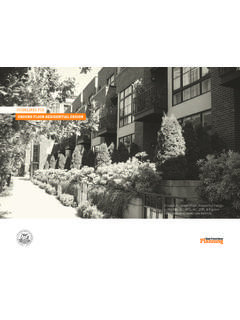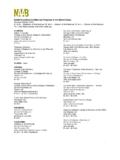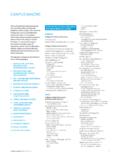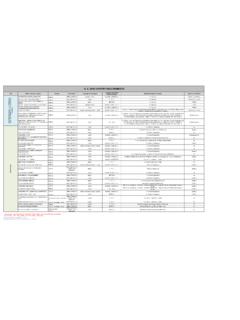Transcription of Disability vs Spatial Planning and Landscaping – Selected ...
1 TEKA 2016, Nr 1 Komisji Architektury, Urbanistyki i Studi w Krajobrazowych Oddzia Polskiej Akademii Nauk w LublinieDisability vs Spatial Planning and Landscaping Selected Examplespawe Szumiga a1, piotr urba ski2 1email: 2email: of Green Space and Landscape architecture , Pozna University of Life Sciencesabstract: The article presents issues related to designing recreational and green areas and Spatial Planning of public areas in the context of physical Disability . It gives exemplary proposals of public space development and Spatial solutions for people with disabilities. It also discusses issues related to the designing and construction of Selected items of landscape architecture for physically disabled people, which were created as part of the education of landscape : physical Disability , architectural barriers, public space Planning , development of green range and manner of satisfying disabled people s needs, especially in terms of their motor activity, is one of basic tasks to do when developing people s surroundings.
2 It chiefly concerns the development of public space. Ubiquitous architectural barriers still cause problems to elderly people, mothers with small children and above all, to disabled people. However, in recent years there has been noticeable progress in this matter. The number of architectural barriers has decreased and at present public investments such as parks, green spaces, urban spaces squares, streets and new buildings are being equipped with facilities for disabled people. The main regulation which describes the issue of accessibility of buildings to disabled people is Article 5, Paragraph 1, No.
3 4 of the Building Code Act of 7 July 1994. According to the Building Code ( Official Journal 2013, Pos. 1490 and Official Journal 2014, Pos. 40, 768, 822), a building and its facilities should be designed and constructed according to the expected time of their use so that they will meet technical and constructional requirements specified in applicable regulations, (..) ensuring that public facilities and multi-family residential buildings are adjusted to the needs of disabled people, especially those on wheelchairs. Detailed regulations specifying the adjustment of buildings to disabled people s needs can be found in the Regulation on the technical require-ments and location of buildings issued by the Minister of Infrastructure on 12 April 2002 (Official Journal No.)
4 75, Pos. 690 of 2002 with later alterations). Thanks to the novelisation of the Building Code we can see progress in this matter. Also, increasing social awareness and users expectations of public space with adequately high Spatial standards resulted in a greater number of facilities and areas equipped with items for physically disabled people. These are chiefly items of street furniture and landscape architecture as well as mechanical devices lo-cated at places with different altitude levels and at entrances to buildings. If there are no disabled facilities in a building and adjacent area, it gives grounds for claiming subsidies to liquidate architectural, technological and transport barriers.
5 It is in agreement with the Regulation of the Minister of Labour and Social Policy of 25 June 2002, specifying the type of tasks for a county which can be financed from the State Fund for Rehabilitation of Disabled Persons (Official Journal No. 96, Pos. 861 of 2002 with later alterations). Thus, each design task must meet the requirements concerning the knowledge of designing, Spatial Planning and Landscaping . Designing is characterised by the fact that it concerns a particular place, which is a component of the environment in its broad social, cultural, industrial, natural and utilitarian sense.
6 Apart from statutory requirements, branch stan-dards and regulations which must be abided by in the process of designing public space, it is also important diSabiL ity v S Spatial pL anning and LandSC aping Selected examp LeS 23to maintain the aforementioned high Spatial standards in facilities. Developing awareness of the issue and de-signing skills are also part of the educational process involved in training architects, landscapers and planners. When students are being educated, they need to design essential facilities, such as car parks, walkways, bicyc-le paths, benches, lamp posts, waste containers, stairs and wheelchair ramps for physically disabled people.
7 Students have to design these elements in a specific Spatial situation, using adequate materials and they have to present technical solutions and visualisations of the designed element of Spatial development in a specific, assigned or Selected Spatial and methodsIn order to illustrate the aforementioned issue in more detail we analysed four Selected examples of student projects done as part of practice in Designing Landscape architecture Facilities, which is a subject at the De-partment of Green Space and Landscape architecture at the Pozna University of Life Sciences. The projects are related with an essential element of landscape architecture , the wheelchair ramp.
8 Legal aspects concerning the design of such facilities are specified in the aforementioned Regulation of the Minister of Infrastructure of 12 April 2002, which lists the technical requirements concerning buildings and their location and provides de-tails of the technical parameters that a design of a wheelchair ramp must meet. Thus, the table below lists the maximum gradient of ramps for pedestrian and wheelchair traffic depending on the ramp 1. The ramp surface gradientNachylenie powierzchni to m15%15% to m8%10% m*6%8%Source: Regulation concerning technical requirements and location of buildings issued by the Minister of Infrastructure on 12 April for pedestrian and wheelchair traffic which are longer than 9 m should be divided into shorter seg-ments by means of landings with a minimum length of m.
9 Planes for traffic on disabled ramps should be at least m wide. They should be equipped with curbs, which must be at least m high, and handrails on both sides. The space between the handrails should not be narrower than 1 m and wider than m. Banisters or walls adjacent to the wheelchair ramp should be fitted with handrails on both sides. The handrails should be placed at and m above the plane of traffic. The horizontal plane of traffic at the beginning and at the end of the ramp should be at least m. The area of the landing next to the wheelchair ramp should be at least m outside the opening field of the entrance door.
10 When both handrails are extended 30 cm beyond the ramp ends, it makes entering and exiting the ramp much easier. Usually the handrail extension is semi-circularly curved, thus connecting the upper and lower handrail. Apart from technical conditions the utilitarian and scenic aspects should also be taken into consideration when developing public space. This as-pect of Landscaping and designing elements of landscape architecture will have fundamental influence on the aesthetics of green space as well as urban space and landscape. The selection and quality of materials as well as colours and shape of forms give space its individual paW e Szumiga a, piotr urba SkiResultsThe examples of ramps and accompanying elements show design solutions with more dynamic forms and col-ours.



